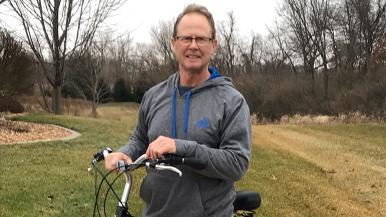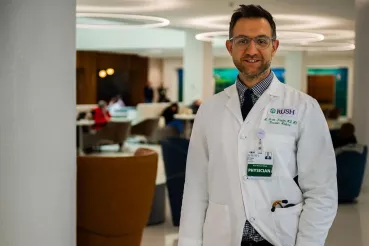Mark Spitz, a 66-year-old resident of Saint John, Indiana, understands the uncertainty that comes from having a family history of premature heart disease. Because Mark’s father had a major heart attack at age 34 and passed away at age 58, his own heart risks were “always in the back of my mind,” he says.
That’s why Mark, who retired a few years ago after a long career as a supervisor in the oil industry, has consistently maintained a heart-healthy lifestyle. He has limited red meat and fried foods, exercised at least five days a week and taken his cholesterol-lowering medicines religiously. Although a heart scan 20 years ago showed some worrisome buildup in Mark’s right coronary artery, his cholesterol and triglyceride levels have always been normal.
But then came the chest pain. In June 2021, Mark was biking laps around his neighborhood when he felt some discomfort in his chest.
“It was just a dull pain in my upper chest that I never really experienced before,” he says. When he stopped riding, the pain went away. “At first, I blew it off. I thought maybe it was indigestion from something I ate,” he says.
Taking chest pain seriously
After a few more bouts of chest pain during exercise — known as stable angina — he told his wife, Michelle, who is a nurse, and they booked a visit to a local cardiologist. Mark’s bloodwork, echocardiogram and stress test results all came back normal. When he started having chest pain on his walks with his British Lab, Dakota, Mark booked an angiogram at his local hospital.
The results surprised him: Mark had complete or nearly complete blockages — also known as chronic total occlusions, or CTOs — in a difficult location in his right coronary artery.
CTOs in the right coronary artery are associated with a higher risk for heart attack as well as a higher risk for complications during angioplasty, a minimally invasive way to open narrowed arteries.
Because of these higher risks, many patients with CTOs like Mark’s are treated with open heart surgery. But with specialized care from doctors at RUSH, Mark was able to relieve his chest pain and return to an active life without the need for invasive surgery.
Finding experts close to home
When the Spitzes researched their treatment options, another local cardiologist said Mark’s blockages were too tricky for him to treat and suggested they meet with Hussam Suradi, MD, an interventional cardiologist specializing in treating patients with complex, high-risk CTOs at RUSH.
When the Spitzes saw Suradi at his office in Dyer, Indiana, just a few miles from their home, they knew they had found the right doctor for them.
“Dr. Suradi was confident he could open my blockages,” Mark says. “He welcomed discussion and questions that Michelle and I had, and we had a lot of them.”
Bypassing the need for bypass
Most angioplasties, also known as percutaneous coronary interventions or PCIs, are performed using an antegrade approach, during which the doctor threads a catheter and wire into the right coronary artery to open it, going with the direction of the patient’s blood flow. But in patients like Mark with complete blockages in the right coronary artery, the blood flow is limited, so finding the right path to open the vessel is more difficult. That’s why these patients have a higher risk for procedural failure as well as complications such as tears in the artery, heart attacks and death during an angioplasty, Suradi explains.
While open heart surgery to bypass the blocked vessels is one option, RUSH has a dedicated interventional cardiology program for complex, high-risk indicated procedures, known as CHIPs. This allows patients like Mark to be treated more safely with angioplasty.
“Having the right equipment, the right support and the right team helps reduce the potential risks,” Suradi says.
Each patient’s case is reviewed by a team of physicians, who work together to come up with the best treatment plan. “We look at things from a fresh perspective, and we discuss all possible options,” Suradi says. Because the RUSH team routinely helps patients with complex coronary artery disease, he recommends that patients get a second opinion if they have chest pain and have been told they are not candidates for angioplasty.
A minimally invasive way to open complex blockages
In January 2022, Suradi performed a highly complex procedure on Mark called a retrograde CTO revascularization, which is only available from interventional cardiologists with advanced training in the technique.
In the cardiac catheterization lab at RUSH University Medical Center, Suradi threaded a wire into Mark’s femoral artery in his groin up to his left coronary artery— basically going “upstream,” against the direction of the blood flow, to reach the blockages from the other side. Then, he passed the wire through the tiny channels of the heart that feed the right coronary artery “collateral vessels,” so the path to open the artery was clear. After that, he used a balloon to open the blockages, place stents and get Mark’s blood flowing freely again.
Although Mark was awake during the procedure, he didn’t feel any pain, just some pressure as Suradi inflated the balloon inside the artery to open it up, he says.
After his procedure, Mark stayed at RUSH overnight under close care from the RUSH staff. “I can’t say enough about the staff, they were great,” he says. He returned home the following day, recuperating quickly with TLC from Michelle.
Living without chest pain — and worry
Two weeks after the procedure, Mark was able to resume his normal routine — without any chest pain. He took his daily walks and got 10,000 steps a day with no discomfort. “I knew right away I was OK,” he says.
Mark no longer takes angina medication and can enjoy bike rides and pheasant hunting with Dakota again. “I couldn’t have done that last summer. There’s no way,” he says. “I can exercise and do other strenuous activities with no limitations. I have had no bouts of angina since the procedure. I feel great.”
Had Mark not been able to have a successful angioplasty, he probably would have had to stop being active or have open heart surgery, Suradi says.
Based on their experience, the Spitzes urge others with a family history of premature heart disease to see a cardiologist even if their tests are normal. And because Mark’s initial heart scan was the only screening test that showed he had buildup in his right coronary artery, they recommend that others who are concerned about their family history get scanned.
As 2023 begins, Mark resolves to maintain his daily exercise routine and to “make a lot of sawdust” in his woodworking shop while enjoying family time with his two daughters and four grandchildren who live close by. “The biggest thing is that I want to be around to see my four grandkids grow up,” he says.
Thanks to expert care from the interventional cardiology team at RUSH, Mark now lives his life with a lot less worry about being there for his family.
“Dr. Suradi is a wonderful doctor,” Mark says. “I am very grateful for what he has done for me.”
RUSH University Medical Center is ranked among the best in the nation in cardiology and heart surgery. For patients in Northwest Indiana, RUSH has opened a multispecialty clinic offering expert heart care in Munster, Indiana.




